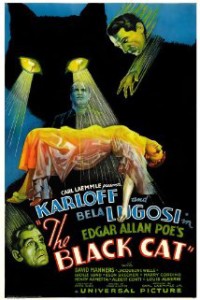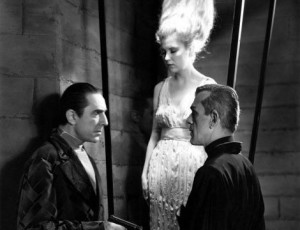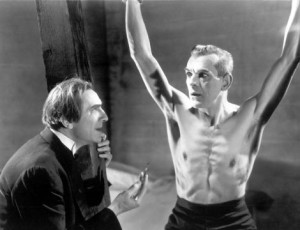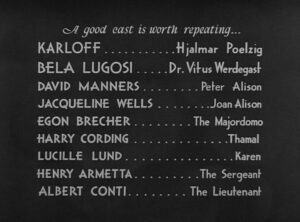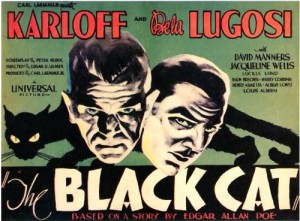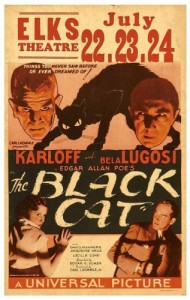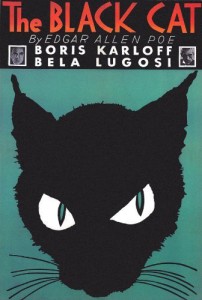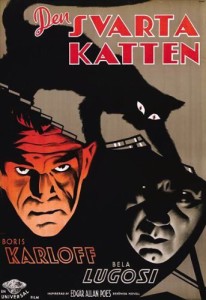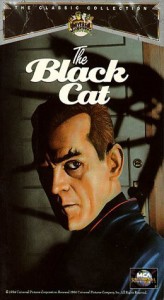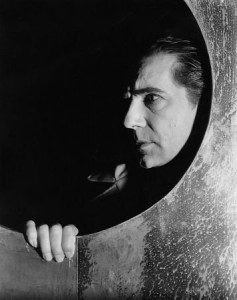The Black Cat ***** (1934, Boris Karloff, Bela Lugosi, David Manners, Julie Bishop) – Classic Movie Review 2504
Hungarian psychiatrist Dr Vitus Werdegast (Bela Lugosi) plots a hideous revenge on his old friend Hjalmar Poelzig (Boris Karloff).
Director Edgar G Ulmer’s weird and wonderful 1934 horror movie The Black Cat brings together Boris Karloff and Bela Lugosi, the immortal stars of Frankenstein and Dracula, in the first of their eight movies together. It is an all-time horror classic.
Hungarian psychiatrist Dr Vitus Werdegast (Lugosi) plots a hideous revenge on his old friend Hjalmar Poelzig (Karloff), an Austrian architect and Satanist, in this bizarre gothic drama that’s kept at near hysteria pitch by director Ulmer.
David Manners and Julie Bishop (billed as Jacqueline Wells) also star as newly-weds Peter and Joan Alison, who learn that due to a mix-up, they have the misfortune to have to share a train compartment with Dr Werdegas on their honeymoon in Hungary.
It transcends merely being daft and camp to be actually haunting, nightmarish and scary. And it contains some wonderfully creepy things like the crazed story, Charles D Hall’s production designs, especially the rotting castle set, John Mescall’s expressionist photography, a satanic rites scene of a black mass with a human sacrifice, and the grizzly skin-stripping flaying climax.
Oh and there’s also necrophilia, drugs, a deadly game of chess, and a spot of torture too. It’s all the true stuff of horror. All in 65 minutes.
This initial pairing of Karloff and Lugosi is probably their most successful, though they happily re-paired for The Raven in 1935. It was the biggest box office hit of the year for Universal Pictures, profiting from the boom in horror after Frankenstein and Dracula in 1931, costing $95,745.31 and taking $236,000 at the box office.
Also in the cast are Andy Devine, John Carradine (uncredited as the organist), Jacqueline Wells, Egon Brecher, Lucille Lund, Henry Armetta, Albert Conti, Anne Duncan, Herman Bing, André Cheron, Luis Alberni, Henry Cording, George Davis, Alphonse Martell, Tony Marlow, Paul Weigel, Albert Polet and Rodney Hildebrand.
The film has little to do with Edgar Allan Poe’s short story The Black Cat, though Poe’s name is listed in the credits (‘Suggested by the immortal Edgar Allan Poe classic’). Peter Ruric (aka pulp writer Paul Cain) wrote the screenplay, based on Ulmer’s scenario, inspired by the life of occultist Aleister Crowley.
The 1941 The Black Cat film with Basil Rathbone, supposedly based on the same Edgar Allan Poe story, has no relation to this one, though Lugosi is in both films.
Heinz Eric Roemheld’s classical music soundtrack was then unusual as an almost continuous background score.
Just to explain the title, early on in the movie, Werdegast kills Poelzig’s black cat, but Poelzig, who keeps dead women on display in glass cases, carries a second black cat around the house with him while he oversees other preserved dead women. Weird and wonderful it is.
Memorable line: Karloff to Lugosi: ‘Do you hear that, Vitus? The phone is dead. Even the phone is dead.’
It was released in UK cinemas as House of Doom.
The cast are Boris Karloff as Hjalmar Poelzig (billed simply as KARLOFF), Béla Lugosi as Dr. Vitus Werdegast, David Manners as Peter Alison, Julie Bishop (billed as Jacqueline Wells) as Joan Alison, Egon Brecher as The Majordomo, Harry Cording as Thamal, Lucille Lund as Karen Werdegast and the elder Karen Werdegast, Henry Armetta as Police Sergeant, Albert Conti as Police Lieutenant, and John Carradine as Organist (uncredited).
A good cast is worth repeating…
Boris Karloff recalled: ‘Certainly, I was typed. But what is typing? It is a trademark, a means by which the public recognizes you. Actors work all their lives to achieve that. I got mine with just one picture. It was a blessing.’
The Universal horror cycle was started by Carl Laemmle Jr (born Julius Laemmle), whose vision and total support for Edgar G Ulmer are behind this classic. Julius (often referred to as Junior) was the heir of Universal Studios founder Carl Laemmle, and was head of production at the studio from 1928 to 1936. His legendary hits include Dracula (1931), Frankenstein (1931), The Mummy (1932), The Old Dark House (1932), The Invisible Man (1933) and Bride of Frankenstein (1935).
© Derek Winnert 2015 Classic Movie Review 2504
Check out more reviews on http://derekwinnert.com

